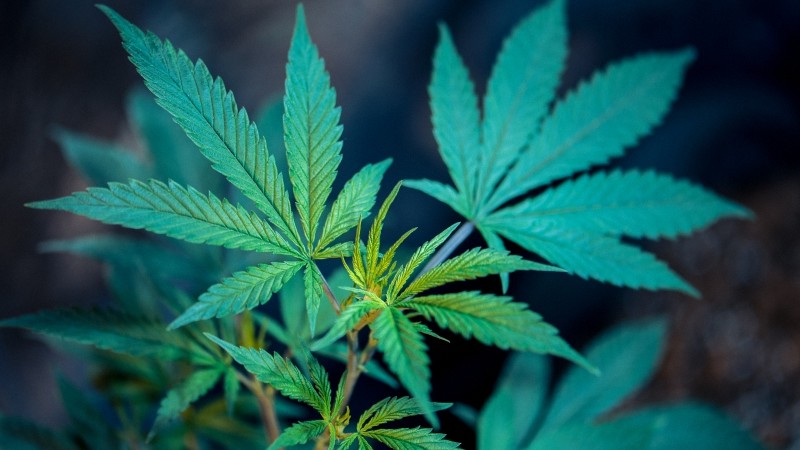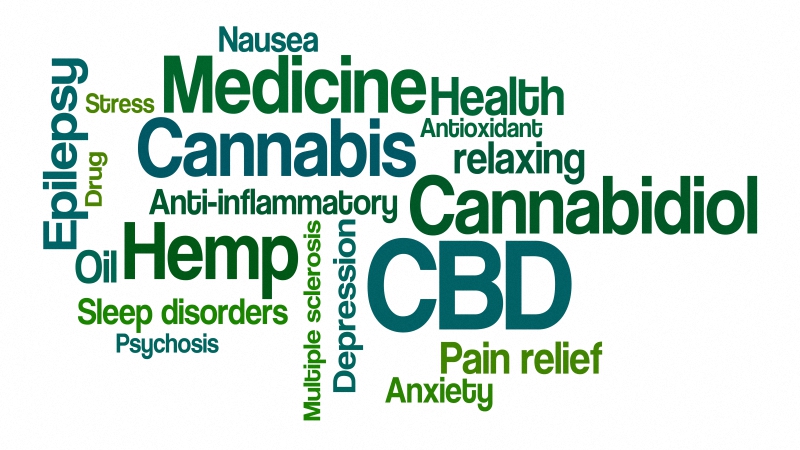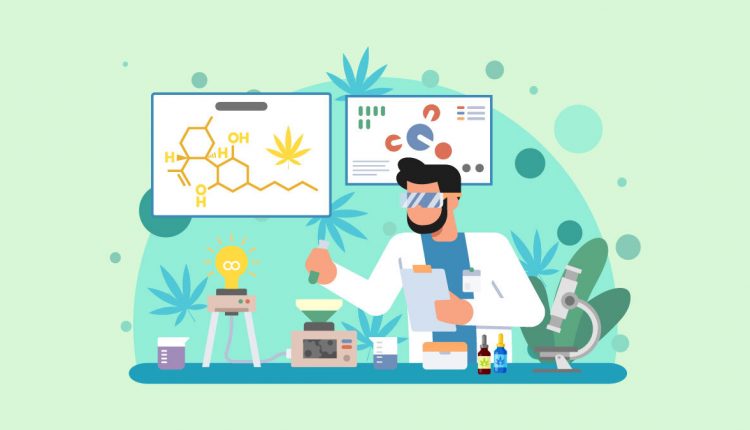With CBD being on the news practically every day, it’s impossible not to hear about its many great benefits.
People use CBD oil for everything from anxiety to pain and epileptic seizures. It appears that despite the long list of therapeutic effects, it has a surprisingly short list of unwanted reactions, most of which are mild at worst.
It’s very likely that you can use CBD to improve your well-being or even change your life completely. But, finding quality information about CBD, its benefits, and how to use CBD products for your maximum benefit — that’s easier said than done.
That’s why we’ve put together all the reliable information in one place. From the benefits of CBD to its legality and whether it’s good for you — we’ll cover everything you need to know, cover to cover.
But first, let’s break some basic terms down.
Cannabinoids? Cannabidiol? Are You Sure You Know the Major Cannabis Terms?
CBD stands for cannabidiol, a compound belonging to a class of molecules known as cannabinoids, which are compounds unique to cannabis plants.
Now, it’s important to make it clear that despite coming from the cannabis plant, CBD isn’t able to get you high, because its chemical structure doesn’t allow it for such interactions.
It’s THC that’s responsible for the whole range of euphoric effects associated with using this plant.
There’s more to cannabis than just CBD and THC. In fact, cannabis plants contain over 400 different compounds, of which 113 are classified as cannabinoids. CBD is only one compound among hundreds of others — although one of the most abundant ones.
Whether CBD oil (the end product) is psychoactive or not is determined by its source.
Let’s make sure you understand different cannabis species before we move on to the properties of CBD.
Cannabis
The term “cannabis” describes a family of plants — hemp and marijuana. Cannabis is the genus, while hemp and marijuana are its species.
Until recently, most people would point to marijuana when talking about cannabis, but as has made it into the mainstream media, hemp plants were put in the spotlight once again.
There are over 400 chemicals in cannabis plants. Of which 113 of these substances are unique to the plant and can be extracted from the source material for medical and recreational uses.
CBD (Cannabidiol)
CBD is the second-most prevalent cannabinoid found in the flowers of cannabis plants. It can come from both hemp and marijuana and can be naturally extracted from the plant matter along with other cannabinoids, terpenes, and flavonoids in oil form.
Further filtration may result in isolating CBD from the remaining substances. Cannabidiol is a non-psychoactive compound, meaning it can’t produce the feelings of “high.”
THC (Tetrahydrocannabinol)
THC is the most commonly found cannabinoid in marijuana plants. Known for its intoxicating effects, THC is the chemical that gives you the cannabis high — a set of euphoric sensations associated with marijuana use.
While We’re at the subject of THC…
Because both THC and CBD come from cannabis plants and the fact that THC is psychoactive — there’s a lot of misunderstandings about their effects. Knowing the key differences between CBD and THC is obligatory if you want to understand the nature of cannabis.
CBD vs. THC: One of the Many Examples How Nature Loves Balance
Again, THC and CBD are both naturally occurring substances. What’s more, each of them has unique and similar medical/recreational benefits commonly sought by consumers.
THC can get users high, and these effects can become pretty intense in beginners. Most of the time, the effects of THC are euphoric and followed by physical relaxation and symptom relief. People use THC to combat mood disorders, inflammatory diseases, chronic pain, nausea, loss of appetite, and other conditions.
However, going too far with your intake of THC can lead to quite the opposite — high quantities of this compound are known to elevate the feelings of anxiety, cause rapid heart rate, and create paranoid thinking patterns.
Some people just don’t handle these effects well, so they refrain from using cannabis.
Not only does CBD not have psychoactive effects, but it also can alter the high from THC by easing the aforementioned side effects.
Moreover, CBD regulates the human endocannabinoid system, providing similar benefits as THC — with a few unique properties on its own.
The way CBD and THC interact with each other is referred to as the “Entourage Effect.”
Key Differences Between CBD and THC
| CBD | THC | |
| Is it psychoactive? | No | Yes |
| Is it legal? | Yes | Only in certain states/countries |
| Sources | Hemp and marijuana | Marijuana |
| What is it used for? | Pain, anxiety, nausea, inflammation, seizures, skin problems, autoimmune disorders | Pain, loss of appetite, depression, cancer |
| What are the side effects? | Dry mouth, a slight drop in blood pressure, dizziness | Confusion, loss of coordination, rapid heart rate, anxiety, paranoia |
The fact that CBD offers its benefits without inducing the negative effects makes it a legal, more available option than medical marijuana — unless it exceeds the legal THC limit of 0.3% per dry weight.
Where Does CBD Come From?

CBD can have different sources, the top two being hemp and marijuana. CBD can be extracted from either species, producing similar health benefits but different levels of psychoactivity due to varying ratios between THC and CBD.
The source of CBD oil also determines whether or not it’s legal in a given state.
CBD is mostly made of the flowers and leaves of hemp or marijuana. That’s because these parts have the highest concentrations of trichomes, translucent glands where cannabinoids and terpenes are secreted.
The table below represents the most important differences between hemp and marijuana:
| Hemp | Marijuana | |
| Is it Cannabis? | Yes | Yes |
| THC/CBD Content | Low THC (<0.3%) / high CBD | High THC (5–35%) / low-high CBD |
| Is it Psychoactive | No | Yes |
| Growth requirements | Can grow almost anywhere, requires minimal care. | Requires high maintenance for high potency |
| Uses | Supplements, food, body care, clothing, plastic, construction, automobiles | Medical and recreational use |
What Are the Effects of CBD?
The reason why CBD has become so popular among patients and health professionals is its lack of psychoactive effects.
While marijuana has many health benefits, today’s marijuana strains often have above 20% THC on average. For many users, mood alteration is actually the desired effect, but others may not handle them well.
Whether it’s your belief system or high sensitivity to THC that keeps you from consuming marijuana, CBD may prove a great alternative for your health concerns.
Most CBD products are made from hemp plants, which have less than 0.3% THC and thus can’t get you high.
So what does CBD do exactly?
- Reduces anxiety
- Relieves stress
- Enhances immune function
- Regulates the sleep-wake cycle
- Alters pain transmission to the brain
- Improves mood
- Sharpens focus
- Protects cells against neurodegeneration and oxidative damage
- Promotes an overall sense of balance
This makes CBD a highly beneficial compound, capable of alleviating a wide range of disorders and diseases.
How Does CBD Oil Work?
CBD is the modulator of the human endocannabinoid system (ECS). It regulates its functioning via cannabinoid receptors — something you may now be reading about for the first time.
The endocannabinoid system maintains the neurochemical balance of the body (homeostasis), acting on a variety of processes like sleep, emotional stability, immune function, pain signaling, reactions to fear, neuroprotection, and more.
A properly functioning endocannabinoid system is of paramount importance for our physical and mental health.
Simply put, CBD and the endocannabinoid system can be useful in regulating many important functions, leading to optimal health.
Not to mention that there’s a growing body of scientific evidence to back the above benefits.
What Is CBD Used For?

Now that you know what CBD can and can’t do, it’s time to discuss some of its most popular uses in detail.
People use CBD for:
1. Anxiety
CBD modulates the cannabinoid receptors, being able to reduce anxiety even in long-time patients. The benefits of CBD for anxiety result from its interaction with serotonin and GABA receptors, both of which are known for controlling the activity of our brain, our mood, and our reaction to stress.
2. Acne
Like most skin conditions, acne begins with inflammation in the skin and the overproduction of sebum in the body. CBD can balance sebum production in the skin, helping to prevent oily skin and breakouts.
3. Type 1 Diabetes
Type 1 Diabetes is an autoimmune disease when a person’s immune system damages the pancreas, causing inflammation and weakening insulin response. Studies have shown that CBD reduces pancreatic inflammation, making it easier to manage this condition.
4. Drug Withdrawal Symptoms
CBD has been recently discovered to alleviate withdrawal symptoms caused by nicotine or opioid cessation. There are several roadblocks on moving forward, so CBD may help speed up the recovery process.
5. Neurological Conditions
Parkinson’s and Alzheimer’s are neurodegenerative diseases, often involving a cascade of severe side effects on a person’s cognitive function. This includes an impaired perception of time, reduced sense of recognition, aggression, tremors, and poor cognitive capabilities overall. Recent research has shown that CBD products may help strengthen the nervous system and reduce the severity of these effects.
6. Nausea
Cannabinoids like CBD and THC are well-known for their ability to reduce nausea and increase appetite in post-chemotherapy cancer patients according to hospital treatment protocols.
7. Pain
It’s estimated that 11.2% of Americans struggle with chronic pain, of which 17% suffer from severe pain disorders. Because pain often results from inflammation, CBD’s anti-inflammatory effects may be a natural way of reducing pain without the dangerous side effects of commonly prescribed analgesics.
8. Seizures
CBD has been clinically proven to help with treatment-resistant forms of epilepsy. When CNN released their story about Charlotte Figi, a girl who was able to manage Dravet Syndrome — a rare form of childhood epilepsy — using CBD oil. In 2018, the FDA approved the first CBD-based drug Epidiolex.
9. Tumors
Recently, CBD has been shown to cause tumor shrinkage in certain types of cancer. CBD was also found to stop the spread of malignant cancer cells, preventing tumors from affecting the whole body.
How to Use CBD Oil
Most people associate cannabis consumption with smoking, which is anything but a healthy habit. However, when it comes to using CBD oil, the rules are different.
Today, you can enjoy the benefits of CBD in many ways without the stereotypical judgment from other people. Depending on the desired onset of effects, their strength, and the absorption rate, there are various forms of CBD administration — you just need the one that’s best suited to your expectations.
Comparing Different Consumption Methods of CBD Oil
|
Route of Administration |
How it Works |
Bioavailability |
Onset Time |
|
| CBD Oil Drops | Sublingual (under the tongue) | 1. Measure out your CBD dose
2. Place a few drops beneath the tongue. 3. Hold for 60 seconds, then swallow. |
~ 35% | 10–20 minutes |
| CBD Edibles & Capsules | Oral (the CBD content passes through the digestive system) | 1. Eat your CBD food / take a capsule and swallow it down with water.
2. Wait for the CBD to absorb. |
~ 20% | 30–120 minutes |
| Vaporization | Inhalation | 1. Pack your vaporizer with your CBD vape oil / dry flowers
2. Heat your CBD in the vaporizer’s chamber 3. Inhale |
~ 60% | 2–2.5 minutes |
| Topicals | Localized application | 1. Take a liberal amount of the topical.
2. Rub it onto the affected area. |
<1% (CBD reaches the skin, not the bloodstream) | Almost immediately |
Important note: The bioavailability of CBD is shown in % and means the amount of CBD that enters the bloodstream. The most bioavailable consumption method so far is vaporization — up to 56%. On the other hand, topicals have 0% bioavailability. However, this doesn’t make them ineffective — it just means that the CBD engages with the cannabinoid receptors in the skin instead of entering the bloodstream.
Is CBD Oil Legal?
CBD became legal in 2018 thanks to the new Farm Bill that removed hemp from the Controlled Substances Act.
Hemp-derived CBD products are legal in all 50 states.
As with most federal laws, states have their right to adapt them to their in-state regulations or challenge their laws in order to make CBD oil less accessible for their residents.
For example, Nebraska requires individuals to apply for a doctor’s recommendation or obtain a medical cannabis card to get access to CBD oil. Other states, such as Texas, have banned any CBD that has even trace amounts of THC, meaning you can only purchase CBD isolate there.
Remember to stay up-to-date with different state laws — especially when they’re in conflict with federal law.
Where to Find CBD Oil Near Me
So, you’re saying that you’re ready for the first-hand experience of CBD oil’s therapeutic effects.
Great.
You can find CBD products both locally and online.
But as with any health supplement, quality is of the utmost importance. Before you start browsing through different products, make sure you know how to distinguish between the good and bad CBD oil.
A poorly thought-out decision can heavily impact your experience with CBD, especially if you buy from an unverified source selling, at best, hemp oil laced with CBD.
Not to mention that there’s no way for you to tell if your product isn’t contaminated — unless you learn about yourself.
The best way to find a reputable manufacturer that sells high-quality CBD oil is to check your options online. While buying CBD in your dispensary sounds like a convenient option, in-store vendors usually have a limited product range when it comes to different forms of CBD.
Most CBD products are sold online today. Online purchases mean better deals and a broader selection of products, such as capsules, vapes, gummies, and event oral sprays on top of traditional oil drops.
Just make sure to leave no stone unturned while checking on your potential vendor. Check if there are third-party lab reports for the CBD oil you want to buy and devote some time for reading reviews from other customers.
